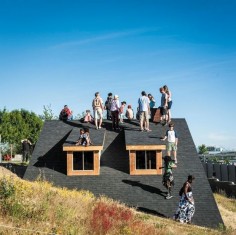HEATHER HART
The Western Oracle: We Will Tear The Roof Off The Mother
source: momaps1org
An object holds a story that is relative and depends wholly on the viewer’s act of reading to give it, and the experience of reading, value. An object’s truth is the unique echo that a viewer may find when reading a re-contextualized object.
I am interested in stirring these echoes, activating these inherited forms. I make environments that direct viewers to become participants. I am interested in generating a memory of an experience, giving the “viewer” some responsibility in the art “viewing” process and creating something that lasts longer than the initial interaction itself. Each participant who engages with my work brings their frame of reference and their ideas to mingle with the environment I have offered as a catalyst. Through play, humor, interaction, and medium, I want to open a conversation that may continue outside of the art piece.
Bio/Resume
Born in Seattle, Heather Hart was an artist in residence at Skowhegan, Santa Fe Art Institute and at the Whitney ISP and recently received a fellowship from NYFA. Her work has been included in a variety of publications and exhibited worldwide including at Socrates Sculpture Park, Art in General, Rush Arts Gallery, Museum of Art and Craft in Japan, Portland Art Center and inside New York subway cars. She studied at Princeton and received my MFA from Rutgers. Hart lives and works in Brooklyn.
.
.
.
.
.
.
.
source: architizer
“The Western Oracle: We Will Tear the Roof Off the Mother,” a new installation at the Seattle Art Museum. Photo: Robert Wade
Attics are magical places. As neglected crawlspaces, reliable hiding spots, and overheated treasure troves that hint at distant lives, attics hold the secrets—or just the cobwebbed junk—of generations past. For the Brooklyn-based artist Heather Hart, attics also present an opportunity for self-contemplation.
So when Hart began building a series of oracle-themed domiciles in 2010, she skipped over the more frequently inhabited porches and rec rooms and zeroed in on attics. Resembling architectural ruins for contemporary times, her A-frame wood houses begin and end at the roof line. “It looks like a house has fallen from the sky and anchored itself in the park,” Sandra Jackson-Dumont, deputy director for education and public programs at the Seattle Art Museum (SAM), says of Hart’s new installation at Olympic Sculpture Park, which opened on Saturday. “It also could look like a roof that’s submerged in water. As people sit on top of it, it may remind people of Katrina or other floods in recent history.” Hart’s newest installation, “The Western Oracle,” overlooks Seattle’s Olympic Sculpture Park and Puget Sound. Photo courtesy the Seattle Art Museum
The new structure, “The Western Oracle: We Will Tear the Roof Off the Mother,” is Hart’s third demi-house. Each of her oracle pieces asks viewers to make an offering in exchange for a gander at self-discovery. At the Brooklyn Museum last year, visitors to the Buddhist-themed “Eastern Oracle” offered bits of gold leaf before facing their own reflections in a mirror. “You became the oracle,” recalls Jackson-Dumont.
“The Northern Oracle: We Will Tear the Roof Off the Mother” (2010), at Franconia Sculpture Park in Minnesota. Photo courtesy the artist
On view through October 13, “The Western Oracle” joins sculptures by Alexander Calder and Mark di Suvero on Weiss/Manfredi’s Z-shaped park path overlooking Puget Sound. Visitors are free to clamber on the roof or duck inside to sit between the attic’s exposed trusses. In a nod to the region’s Native American heritage, this attic features a wall made of drums. The hides are stretched to varying tensions to produce an array of sounds. Visitors are encouraged to make impromptu musical offerings, says Jackson-Dumont. “Oracles are about speaking truth,” she adds. “This is meant to be a reflective experience.”
It’s also meant to be a physical one. As Hart explained to ArtSlant when “The Eastern Oracle” opened in Brooklyn, “I love making things, but I also want my conceptual work to be an experience that lasts longer than the viewing process. I believe that involving all the senses and creating a task or physical action of some kind can access people more deeply than through solely visual stimulation.”


